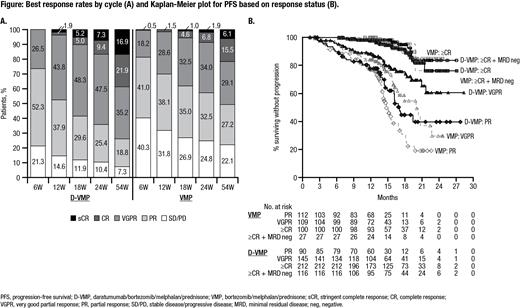Abstract
Introduction: Daratumumab is a human IgGκ monoclonal antibody that targets CD38 with a direct on-tumor and immunomodulatory mechanism of action. In the primary analysis (median follow-up, 16.5 months) of the global phase 3 ALCYONE trial, daratumumab in combination with bortezomib, melphalan, and prednisone (D-VMP) significantly improved progression-free survival (PFS) versus VMP alone in patients with newly diagnosed multiple myeloma (NDMM) who were ineligible for transplant (median PFS, not reached vs 18.1 months; hazard ratio [HR], 0.50; 95% confidence interval [CI], 0.38-0.65; P<0.001). In the primary analysis (median follow-up, 12.3 months) of the phase 3 OCTANS trial, D-VMP significantly prolonged PFS versus VMP in transplant-ineligible Asian patients with NDMM (median PFS, not reached vs 18.2 months; HR, 0.43; 95% CI, 0.24-0.77; P=0.0033). Here, we present a pooled subgroup analysis of PFS stratified by best response in Asian and global patients from the OCTANS and ALCYONE studies, respectively.
Methods: Eligible patients in OCTANS and ALCYONE were ≥18 years of age, were diagnosed with NDMM, and were not eligible for autologous stem cell transplant due to age (≥65 years) or comorbidities. All patients received up to 9 cycles (42-days) of bortezomib (1.3 mg/m 2; subcutaneous) twice weekly on Weeks 1, 2, 4, and 5 of Cycle 1 and once weekly on Weeks 1, 2, 4, and 5 of Cycles 2 to 9; melphalan (9 mg/m 2; oral) once daily on Days 1 to 4 of each cycle; prednisone (60 mg/m 2; oral) once daily on Days 1 to 4 of each cycle. For patients in the D-VMP group, daratumumab (16 mg/kg, intravenous) was administered once weekly in Cycle 1, once every 3 weeks in Cycles 2 to 9, and once every 4 weeks thereafter until disease progression or unacceptable toxicity. Response over time (at 6, 12, 18, 24, 54 weeks) and disease progression were assessed by a validated computer algorithm in accordance with the IMWG criteria. Minimal residual disease (MRD) negativity (10 -5) was assessed by multi-parameter flow cytometry in OCTANS and by next-generation sequencing in ALCYONE.
Results: In the OCTANS study, 220 Asian patients were randomized (D-VMP, n=146; VMP, n=74); in the ALCYONE study, 706 global patients were randomized (D-VMP, n=350; VMP, n=356). Median age in OCTANS was 69 (range, 57-84) years and 71 (range 40-93) years in ALCYONE.
Patients were pooled from both studies (D-VMP, n=496; VMP, n=430). D-VMP increased the rate of complete response or better (≥CR; 10.2% vs 5.6%) and the rate of very good partial response or better (≥VGPR; 58.5% vs 38.1%) versus VMP after 18 weeks of treatment (Figure A). Responses deepened over time among patients in both the D-VMP and VMP groups, as shown by the ≥CR rate (D-VMP, 38.8%; VMP, 21.6%) and the ≥VGPR rate (D-VMP, 74.0%; VMP, 50.7%) at 54 weeks. At a median follow-up of 12.3 months for OCTANS and 16.5 months for ALCYONE, among patients who achieved a VGPR (D-VMP: n=145 [29.2%]; VMP: n=109 [25.3%]), the median PFS was not reached in the D-VMP group versus 19.9 months in the VMP group (HR, 0.61; 95% CI, 0.36-1.00; P=0.0499; Figure B). All patients who achieved ≥CR with or without MRD negativity (10 -5) demonstrated prolonged PFS, regardless of treatment (≥CR: HR, 1.54; 95% CI, 0.65-3.65; P=0.3210; ≥CR+MRD negativity: HR, 0.67; 95% CI, 0.13-3.40; P=0.6225; Figure B); however, more patients treated with D-VMP achieved this level of response (≥CR: D-VMP , n=212 [42.7%]; VMP, n=100 [23.3%]; ≥CR+MRD negativity: D-VMP, n=116 [23.4%]; VMP, n=27 [6.3%]; Figure B).
Conclusion: In a pooled analysis of OCTANS and ALCYONE, more patients with transplant-ineligible NDMM achieved deeper responses with D-VMP versus VMP. More patients treated with D-VMP achieved ≥CR with or without MRD negativity compared with those treated with VMP alone, leading to prolonged PFS regardless of treatment. These results support the use of daratumumab in addition to VMP in transplant-ineligible Asian patients with NDMM.
Wang: AbbVie: Consultancy; Astellas Pharma, Inc.: Research Funding. Kim: BMS: Consultancy, Honoraria, Research Funding; Janssen: Consultancy, Honoraria, Research Funding. Li: Suzhou Zelgen Biopharmaceuticals Co.,Ltd.: Honoraria. Chim: Janssen, Takeda & Amgen: Other: received sponsorship for overseas meetings. Rodriguez-Otero: Janssen: Consultancy, Honoraria, Membership on an entity's Board of Directors or advisory committees; Celgene-BMS: Consultancy, Honoraria, Membership on an entity's Board of Directors or advisory committees; GSK: Consultancy, Honoraria, Membership on an entity's Board of Directors or advisory committees; Pfizer: Consultancy; Sanofi: Honoraria, Membership on an entity's Board of Directors or advisory committees; Kite: Honoraria, Membership on an entity's Board of Directors or advisory committees; Amgen: Honoraria; Regeneron: Honoraria; Clínica Universidad de Navarra: Current Employment. Liberati: abbvie, amgen, archigen, beigene, BMS, celgene, DR REDDY'S LABORATORIES SPA, fibrogen, glaxo, Janssen, Karyopharm, Morphosys, Novartis, Onconova, Oncopeptides ab, Roche, Sanophi, Secura Bio, Takeda, Verastem,: Research Funding. Takamatsu: Bristol-Myers Squibb: Honoraria, Research Funding; SRL: Consultancy; Adaptive Biotechnologies, Eisai: Honoraria; Janssen: Consultancy, Honoraria, Research Funding. Dimopoulos: BMS: Honoraria; Takeda: Honoraria; Beigene: Honoraria; Janssen: Honoraria; Amgen: Honoraria. Wroblewski: Janssen: Current Employment, Current equity holder in publicly-traded company. Carson: Janssen: Current Employment. Qi: Janssen: Current Employment, Current equity holder in publicly-traded company. Wang: Janssen: Current Employment. Song: Janssen: Current Employment. Jia: Janssen: Current Employment. Yang: Janssen: Current Employment, Current equity holder in publicly-traded company. Liu: Janssen: Ended employment in the past 24 months. Li: Janssen: Current Employment. Zhang: Janssen: Current Employment.


This feature is available to Subscribers Only
Sign In or Create an Account Close Modal